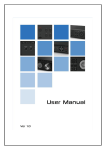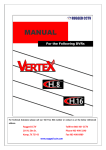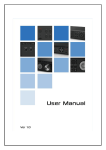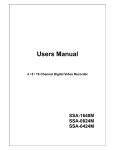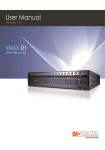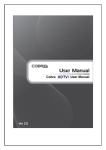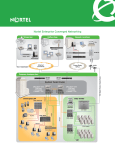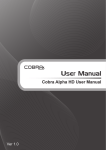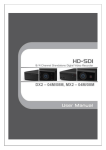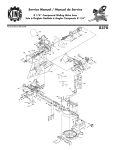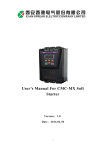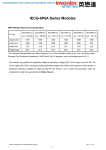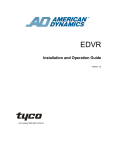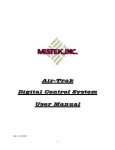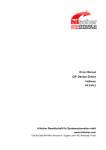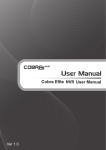Download User Manual - Rugged CCTV
Transcript
User Manual
Rugged CCTV – 866-301-CCTV – www.rugged-cctv.com
FCC Compliance Statement
Model Name:
RUGGED HD
This device complies with Part 15 of the FCC Rules. Operation is Subject to the following two conductions: (1)
this device may not cause harmful interference, and (2) this device must accept any interference received,
including interference that may cause undesired operations.
WARNING
Unauthorized reproduction of all or part of this manual is strictly prohibited.
The figures in this manual are for illustration purposes only (may differ from the actual product).
The specifications and design of the product are subject to change without prior notice for purposes of quality
improvement.
CAUTIONS
To get the best use out of the product, be sure to read the cautions before using the product. For safety, please
take note of the following.
Instructions before using the product
To prevent electric shock when installing, moving, or opening the DVR and peripheral devices, connect
and disconnect the cables as instructed. All cables must be connected to grounded power outlets.
If the product is installed near a power outlet, make sure it can be unplugged easily.
Do not use the DVR in water or in wet places.
Keep the plastic packing materials used for the DVR or other peripheral devices out of reach of children
(may cause suffocation).
Installation Environment of the DVR
Maintain the following conditions: operating temperature of 5˚C ~ 40˚C; operating humidity of 10% ~ 80%.
Install the DVR in a safe place that is free from external vibration.
Install the DVR in a well-ventilated place.
To protect the hard disk from data loss and breakdown, install the DVR away from magnetic materials.
When using a rack other than the standard one, use a separate table with sufficient spacing, i.e., 60cm
from the floor, 50cm from the ceiling, and 20cm from the side and back walls and other objects.
1
2
3
4
1
2
3
4
5
Safety Notes on the DVR
When installing additional boards and HDD, separate the power cable and turn OFF power supplied to the
DVR completely..
2 Keep the product away from heat-generating devices such as heaters.
3 Do not use a damaged power cord.
4 To prevent problems due to magnetic interference and electric surge, use only grounded cables and
power outlets.
5 If the power cord is connected, do not touch the power unit. If the power cord is connected, electric current
is still flowing internally even after the switch is turned OFF.
6 Do not place a heavy object on top of the product.
7 Do not drop a conductive object in the ventilation holes.
8 Allot sufficient space for system cabling.
9 Use only the parts indicated in the manual. Do not disassemble, repair, or modify the product without
permission.
10 Incorrect system setup may cause malfunction.
11 Shut down the system normally as instructed in the manual.
1
Safety Notes on the Lithium Battery
1
1
2
Replace lithium batteries as instructed to avoid danger.
Dispose used lithium batteries properly.
【Warning and Caution are indicated as follows.】
Possible injury or product damage.
Risk of minor injury or product damage.
Cautions for the usage of the product.
Information for the usage of the product.
2
Chapter 1. Introduction .................................................................. 7
1-1 HD1 series Major Features ..................................................................... 7
1-2 Components ........................................................................................ 8
1-3 HD1 Product Introduction ...................................................................... 9
Chapter 2. Installation and connection .......................................... 10
2-1 HD1 series Names and Features of Each Part ........................................ 10
2-1-1
2-1-2
2-1-3
2-1-4
HD1-1648T Rear Panel ............................................................................ 10
HD1-824T Rear Panel ............................................................................. 10
HD1-1648H Rear Panel ........................................................................... 10
HD1-824H Rear ..................................................................................... 10
2-2 Installation and Connection .................................................................. 11
2-2-1 Basic Connection ................................................................................... 12
2-3 Connection of Other Devices ............................................................... 13
Chapter 3. Operation and Setup Tools........................................... 15
3-1
3-2
3-3
3-4
HD1 series Front Panel Button ............................................................. 15
HD1 series Remote Controller .............................................................. 16
Mouse............................................................................................... 17
Jog/Shuttle ........................................................................................ 17
Chapter 4. DVR Operation Setup .................................................. 18
4-1 HD1 series Storage Installation ............................................................. 18
4-2 Power ON. ......................................................................................... 20
4-3 HD frequency setting .......................................................................... 20
4-4 Storage Setup .................................................................................... 20
4-5 Recording Setup ................................................................................ 20
4-6 Date/Time Setup ................................................................................ 21
4-7 Camera / TV Setup ............................................................................. 21
4-8 Screen View and Other Setup ............................................................... 21
4-9 External Device Setup ......................................................................... 21
4-10 Recording View ............................................................................... 21
4-11 Backup .......................................................................................... 21
4-12 DVR Information View ....................................................................... 21
Chapter 5. System Operation ....................................................... 22
5-1 Real Time Monitoring Mode and Icon .................................................... 22
5-2 System Login ..................................................................................... 23
5-2-1 User Account and Authorization ................................................................. 23
5-2-2 Login ................................................................................................... 23
5-2-3 Logout ................................................................................................. 24
5-3 Monitoring ......................................................................................... 24
5-3-1
5-3-2
5-3-3
5-3-4
5-3-5
5-3-6
Screen Division and Auto Sequence ............................................................ 24
Channel Grouping .................................................................................. 25
Spot .................................................................................................... 25
Menu in Monitoring Mode ......................................................................... 26
Zoom .................................................................................................. 26
Screen Control by using PTZ ..................................................................... 27
5-4 System Information and Screen Setup Change ....................................... 28
5-4-1 System Information ................................................................................. 28
5-4-2 Screen Brightness/Contrast/Color/Saturation/Sharpen/Camera Adjustment ........... 28
5-4-3 Display Setting....................................................................................... 29
5-5 Control .............................................................................................. 29
3
5-6 Search .............................................................................................. 30
5-6-1 Search Mode ......................................................................................... 30
5-6-2 Playback Menu ...................................................................................... 30
5-7 Calendar Search ................................................................................. 31
5-7-1
5-7-2
5-7-3
5-7-4
5-7-5
5-7-6
5-7-7
Search Mode ......................................................................................... 31
Year/Month/Day Selection ........................................................................ 31
Time Index............................................................................................ 31
Event .................................................................................................. 31
Multi-Channel Search .............................................................................. 31
Multi-Time Search .................................................................................. 32
Multi-Day Search .................................................................................... 32
5-8 Playback ........................................................................................... 32
5-8-1 Playback and Playback Speed Control ......................................................... 33
5-8-2 Smart Search ........................................................................................ 34
5-8-3 PCD Search .......................................................................................... 35
5-8-4 Calendar Search .................................................................................... 35
5-8-5 MULTI TIME ......................................................................................... 35
5-8-6 MULTI DAY .......................................................................................... 35
5-8-7 MULTI CHANNEL................................................................................... 35
5-8-8 Panorama Play ...................................................................................... 35
5-8-9 Event .................................................................................................. 36
5-8-10 Audio................................................................................................ 36
5-8-11 Backup ............................................................................................. 36
5-8-12 Screen Mode ...................................................................................... 36
5-9 Log Viewer ........................................................................................ 36
5-9-1 Log Type .............................................................................................. 36
5-9-2 System Log Viewer ................................................................................. 37
5-10 Recording ...................................................................................... 37
5-10-1 Recording Types ................................................................................. 37
5-10-2 Recording Setup ................................................................................. 37
5-10-3 Recording Status View .......................................................................... 38
5-11 Backup .......................................................................................... 38
5-11-1
5-11-2
5-11-3
5-11-4
5-11-5
5-12
5-13
5-14
5-15
5-16
Backup in The Real-Time Monitoring Mode ................................................ 38
Backup in Search Mode ........................................................................ 38
Backup in Log Mode ............................................................................. 39
Backup in Playback Mode ...................................................................... 39
Common Backup Procedure ................................................................... 39
Setup Backup ................................................................................. 40
Log Backup .................................................................................... 41
Print .............................................................................................. 41
NAS Backup ................................................................................... 41
Snapshot ........................................................................................ 42
Chapter 6. Setup ....................................................................... 43
6-1 Time ................................................................................................. 43
6-1-1 Time Sever ........................................................................................... 43
6-1-2 Date and Time ....................................................................................... 44
6-1-3 Standard Time Zone................................................................................ 44
6-2 Definition .......................................................................................... 45
6-2-1
6-2-2
6-2-3
6-2-4
Camera................................................................................................ 45
POS .................................................................................................... 45
Event Source ........................................................................................ 45
Relay .................................................................................................. 46
6-3 Action ............................................................................................... 46
6-3-1 Schedule Selection (Schedule1 ~ Schedule4) ................................................ 47
6-3-2 Event .................................................................................................. 47
6-3-3 Recording ............................................................................................. 47
4
6-3-4
6-3-5
6-3-6
6-3-7
Alarm .................................................................................................. 48
Duration ............................................................................................... 48
Log ..................................................................................................... 48
Advanced ............................................................................................. 48
6-4 Schedule ........................................................................................... 48
6-4-1 Schedule Setup ..................................................................................... 49
6-5 Storage ............................................................................................. 49
6-5-1 Max. Recording Days .............................................................................. 49
6-5-2 HDD Overwrite ...................................................................................... 49
6-5-3 Local Storage Management ...................................................................... 50
6-6 Network ............................................................................................ 53
6-6-1
6-6-2
6-6-3
6-6-4
6-6-5
6-6-6
Ethernet ............................................................................................... 53
DDNS .................................................................................................. 53
Port..................................................................................................... 54
E-mail .................................................................................................. 54
Bandwidth ............................................................................................ 54
Callback ............................................................................................... 54
6-7 System.............................................................................................. 55
6-7-1 DVR Name ........................................................................................... 55
6-7-2 ID for Remote Controller........................................................................... 55
6-7-3 ID For Keyboard Controller ....................................................................... 56
6-7-4 User Registration.................................................................................... 56
6-7-5 Admin. Password ................................................................................... 56
6-7-6 Upgrade ............................................................................................... 56
6-7-7 Factory Default ...................................................................................... 57
6-7-8 RS232C Port ......................................................................................... 58
6-7-9 Alarm .................................................................................................. 58
6-7-10 Alarm Duration .................................................................................... 58
6-7-11 Menu Time Out ................................................................................... 58
6-7-12 Language .......................................................................................... 58
A/P/P/E/N/D/I/X ........................................................................... 59
(1) Recommended HDD Specification ............................................................... 59
(2) Recommended PTZ Camera Protocol ........................................................... 59
(3) Recommended USB2.0 Device ................................................................... 59
5
[Figure
[Figure
[Figure
[Figure
[Figure
[Figure
[Figure
[Figure
[Figure
[Figure
[Figure
[Figure
[Figure
[Figure
[Figure
[Figure
[Figure
[Figure
[Figure
[Figure
[Figure
[Figure
[Figure
[Figure
[Figure
[Figure
[Figure
[Figure
[Figure
[Figure
[Figure
[Figure
[Figure
[Figure
[Figure
[Figure
[Figure
[Figure
[Figure
[Figure
[Figure
[Figure
[Figure
[Figure
[Figure
[Figure
2-1. HD1-1648T Basic Connection and Device Connection] ......................................... 11
2-2. HD1-1648H Basic Connection and Device Connection] ........................................ 12
2-3 . HD1-1648 series Terminal Block and Description] ............................................... 13
2-4. HD1-824 series Terminal Block and Description] ................................................. 13
4-5. Menu Window] ............................................................................................... 20
5-7. Recording Status Window] ............................................................................... 22
5-8. Login Window] ............................................................................................... 23
5-9. Big / Biggest Channel Mode] ............................................................................ 24
5-10 . HD1-1648T / HD1-1648H Channel Mode] ....................................................... 24
5-11 . HD1-824T / HD1-824H Channel Mode] ........................................................... 24
5-12 . Spot] ......................................................................................................... 26
5-13. Zoom Control Screen] ................................................................................... 26
5-14. PTZ Setup] .................................................................................................. 27
5-15. PTZ Control] ................................................................................................ 27
5-16. PTZ Control Min./Max.] .................................................................................. 28
5-17. Product Information Window] .......................................................................... 28
5-18. Screen Setup Window] ................................................................................... 29
5-19. Display Setting Window]................................................................................. 29
5-20. Audio]
[Figure 5-21. Relay] .................................... 30
5-22. Text] ........................................................................................................... 30
5-23. Playback Menu] ............................................................................................ 30
5-24. Search Window] ........................................................................................... 31
5-25. Playback Screen] .......................................................................................... 32
5-26. Playback Status and Control Window]............................................................... 33
5-27. Playback Menu] ............................................................................................ 34
5-28. Smart Search Area Designation] ...................................................................... 34
5-29. Smart Search Motion Detection Window] ........................................................... 35
5-30. Panorama Playback] ...................................................................................... 35
5-31. Display Mode] .............................................................................................. 36
5-32. Log View] .................................................................................................... 36
5-33. Move to the log list of the certain time zone in Log View] ..................................... 37
5-34. Backup Window] ........................................................................................... 39
5-35. Backup and Sub-menu Setup Backup] ............................................................. 40
5-36. Setup Upgrade] ............................................................................................ 40
5-37. Log Backup] ................................................................................................ 41
5-38. Setup / Time Menu] ....................................................................................... 43
5-39. Setup / Definition Menu] ................................................................................ 45
5-40. Motion Area Setup] ....................................................................................... 46
5-41. Setup / Action] ............................................................................................. 46
5-42. Pop up Alarm] .............................................................................................. 48
6-43. Schedule Window] ........................................................................................ 48
6-44. Storage Window (Local)] ................................................................................ 49
6-45. Storage Format Procedure] ............................................................................. 52
6-46. Setup Network Window] ................................................................................. 53
6-47. System Setup Window] .................................................................................. 55
6-48. Firmware Upgrade Progressing Window] ........................................................... 57
6
Chapter1.Introduction
1-1 HD1 series Major Features
System
Format
OS
Video Input
Video
Output
Monitor
Loop
Spot
Audio Input
Audio Output
Compression Format
Recording Speed
Recording Resolution
Recording mode
Alarm Interface
Video Output Resolution
POS / ATM Interface
Backup & Copy Access
Network Access
PTZ / Controller Access
Internal HDD / Internal ODD
System Operation &
Adjustment
System Upgrade
Network
Others
HD1-1648T – Not Available
HD1-824T – Not Available
Reliable Standalone DVR
16Ch – D1 480/400
8ch – D1 240/200
Embedded Linux - Built in Flash Memory
16 BNC
8 BNC
1 BNC, 1 VGA, 1 HDMI
16 BNC
8 BNC
1 BNC - Single or Quad
Line Input : 16 RCA
Line Input : 8 RCA
Line Output : 1 RCA
Video : Standard H.264 / Audio : G.723
1/8, 1/4, 1 ~ 30(25)fps, Total max. D1 480/240(400/200)fps
CIF, 2CIF, 4CIF
Continuous, Event (Sensor, Motion, Audio, Pattern, Text), Schedule
16 Sensor Input, NC/NO - Terminal Block
8 Sensor Input, NC/NO - Terminal Block
4 Relay Output, NC/NO - Terminal Block
2 Relay Output, NC/NO - Terminal Block
HDMI : Full HD(1920x1080), WSXGA+(1680x1050), SXGA(1280x1024)
VGA : WSXGA+(1680x1050), SXGA(1280x1024)
BNC : SDTV(720x480(576))
8 RS232C Simplex - Terminal Block
4 RS232C Simplex - Terminal Block
DVD-RW, USB2.0, Network
Ethernet 10/100 - RJ45
RS485 Half Duplex - Terminal Block
SATA HDD Max. 3ea / SATA Type DVD 1ea
Front Panel Button, Jog/Shuttle, Mouse, IR Remote Control, Keyboard Controller,
Network
USB2.0 Memory Stick, Network
System Automation (Controlled by CMS)
NTP Supported
CMS / Monitoring by Web Browser / PDA
17 Languages Supported, Automatic E-mail
Power [12V/5A] / Max. Power Consumption[60W] / Operating Temperature[5-40℃]
Weight without HDD[8kg] / Dimension[440*88*430mm]
7
Rugged HD
System
Format
OS
Video Input
Video
Output
Monitor
Loop
Spot
Audio Input
Audio Output
Compression Format
Recording Speed
Recording Resolution
Recording mode
Alarm Interface
Video Output Resolution
POS / ATM Interface
Backup & Copy Access
Network Access
PTZ / Controller Access
Internal HDD / Internal ODD
System Operation &
Adjustment
System Upgrade
Network
Others
HD1-824H – Not Available
Reliable Standalone DVR
16Ch – D1 480/400
8ch – D1 240/200
Embedded Linux - Built in Flash Memory
16 BNC
8 BNC
1 BNC, 1 VGA, 1 HDMI
16 BNC
8 BNC
4 BNC - Single or Quad
1 BNC - Single or Quad
Line Input : 16 RCA
Line Input : 8 RCA
Line Output : 1 RCA
[Video : Standard H.264)] / [Audio : G.723]
1/8, 1/4, 1 ~ 30(25)fps, Total max. D1 480/240(400/200)fps
CIF, 2CIF, 4CIF
Continuous, Event (Sensor, Motion, Audio, Pattern, Text), Schedule
16 Sensor Input, NC/NO - Terminal Block
8 Sensor Input, NC/NO - Terminal Block
4 Relay Output, NC/NO - Terminal Block
2 Relay Output, NC/NO - Terminal Block
HDMI : Full HD(1920x1080), WSXGA+(1680x1050), SXGA(1280x1024)
VGA : WSXGA+(1680x1050), SXGA(1280x1024)
BNC : SDTV(720x480(576))
8 RS232C Simplex - Terminal Block
4 RS232C Simplex - Terminal Block
eSATA, DVD-RW, USB2.0, Network
Ethernet 10/100/1000 - RJ45
RS485 Half Duplex - Terminal Block
SATA HDD Max. 6ea / SATA Type DVD 1ea
Front Panel Button, Jog/Shuttle, Mouse, IR Remote Control, Keyboard Controller,
Network
USB2.0 Memory Stick, Network
System Automation (Controlled by CMS)
NTP Supported
CMS / Monitoring by Web Browser / PDA
17 Languages Supported, Automatic E-mail
90 ~ 250V, 50/60Hz , 80 Watts / Operating Temperature [5 ~ 40℃]
Weight without HDD [8kg] / Dimension [440 x 88 x 430 mm]
1-2 Components
After unpacking the product, check whether following accessories are included.
-
Remote Controller
CD (CMS, CMS Manual, PDA Viewer software)
AAA 1.5V Batteries 2ea
Adapter (12VDC/5A) HD1-T Models, Power code HD1-H Models
User Manual
Handle
8
1-3 HD1 Product Introduction
D1(4CIF) real-time recording
16Ch audio recording
4Ch spot output(HD1-1648H) / 2Ch spot output(HD1-1648T)
Various video output port (HDMI, VGA, BNC)
Various video output mode (Full HD, WSXGA+, SXGA, SDTV)
6 HDD bay
Jog-shuttle
8Ch POS/ATM interface
Pre-alarm recording
Watermarking & watermarking detection
Auto e-mailing notification max. 5 users
Privacy zone mask
Covert channel
Digital single/multi-zoom
Smart search
Pattern change / Text detection/search
Multi-time/day, Index (event) search/playback
Panorama playback
Data backup to NAS over ethernet
Still image capture Full HD resolution
Direct printer connection through USB2.0
Firmware upgrade at a remote PC site
Remote setup, backup, relay control
USB/DVD backup with self-executable player (quick viewer)
Web monitoring in PC (Built in web server)
PDA viewer (Windows mobile)
Mobile web viewer (3G viewer)
NTP, DST, DDNS, DHCP
9
Chapter2.Installationandconnection
2-1 HD1 series Names and Features of Each Part
2-1-1 HD1-1648T Rear Panel
2-1-2 HD1-824T Rear Panel
2-1-3 HD1-1648H Rear Panel
2-1-4 HD1-824H Rear
10
No.
1
2
Name
DC 12V IN
Terminal Block
3
SPOT
4
5
6
7
8
9
TV OUT
AUDIO OUT
HDMI
VGA-OUT
Ethernet
RS-232C
10
CONFIG
11
12
13
14
15
16
USB2.0
USB2.0 / e-SATA
CAMERA IN
LOOP OUT
AUDIO IN
Ventilating
Opening
Power
Feature
Power cable connection to the body (HD1-T series)
RS-485 / SENSOR IN / RELAY OUT / RS-232C
CCTV monitor connection to output images of the channel
generating an event signal
CCTV monitor connection
Audio Output Connection(Line Only Output)
HDMI Output
VGA Monitor or LCD Monitor Connection
ADSL, Cable Modem, Ethernet 10/100 Base-T, Network Connection
Console Output
NTSC/PAL
VGA/TV
Full HD(1920x1080), HD(1920x1080)
WSXGA+(1680x1050), SXGA(1280x1024)
(HD1-T series)
(HD1-H series)
Video Camera Connection
Video Signal loop-back Output Connection
Audio Input Connection
Type
DC-power jack
Terminal Block
USB Type A,
e-SATA
BNC
BNC
RCA
(HD1-H series)
Power supply Fan
90 ~ 250V, 50/60Hz, 80 Watts (HD1-H series)
AC Inlet
(3p, female)
BNC
BNC
RCA
HDMI type-C
D-SUB 15P
RJ-45
D-SUB 9P
DIP S/W, 4-pin
2-2Installation and Connection
[Figure 2-1. HD1-1648T Basic Connection and Device Connection]
11
[Figure 2-2. HD1-1648H Basic Connection and Device Connection]
2-2-1 Basic Connection
※ By referring to above [Figure 2-1] ~ [Figure 2-2], make a connection accordingly.
Connection
Order
1
Connection Device
CCTV Camera
DVR Terminal
2
CONFIG SWITCH Setup
3
4
5
CCTV Monitor
VGA Monitor / LCD Monitor
HDMI Monitor
Rear Panel Video IN
Rear Panel Left 4ea Switch
(Refer to below; CONFIG SWITCH Setup)
Rear Panel TV
Rear Panel VGA-OUT
Rear Panel HDMI
6
Mouse
Rear Panel USB
CONFIG SWITCH Setup
Switch 1
Switch 2
Switch 3
Switch 4
Switch 3 / 4 Resolution
FULL HD ( 1920 * 1080 )
HD ( 1920 * 1080 )
WSXGA+ ( 1680 * 1050 )
SXGA ( 1280 * 1024 )
※ In the TV mode, GUI is not displayed through VGA/HDMI output but only a channel
title is shown.
※ Only VGA is available in higher than the HD mode.
12
2-3 Connection of Other Devices
HD1 series has differences in feature as
cautious.
described below. Be
Item
Internal
HDD
Bay
Spot
HD1 T series (1648/824)
HD1 H series (1648/824)
3 SATA
6 SATA
1 BNC - Single or Quad
4/1 BNC - Single or Quad
Item
1648 series
824 series
Audio
16
8
Sensor
16
8
Relay
POS
4
8
2
4
Connect the PTZ controller cable, audio input/output, network, and sensors as shown below.
Connecting Device
DVR Terminal
1
SPOT Monitor(CCTV Monitor)
Rear Panel SPOT
2
Mike / Speaker
Rear Panel Audio Input / Audio Output
3
LAN Cable
Rear Panel Ethernet
4
PTZ Camera
Rear Panel Terminal Block
5
Sensor / Relay / POS
Rear Panel Terminal Block
6
Keyboard controller
Rear Panel Terminal Block
1) SPOT Monitor
Connect Spot Monitor to the rear SPOT terminal.
HD1-1648H supports 4ea SPOT terminals and HD1-1648T / HD1-824T / HD1-824H support 1ea SPOT terminal.
2) Audio Input/Output
HD1-1648T / HD1-1648H support 16ea audio inputs and HD1-824T / HD1-824H support 8ea audio inputs.
HD1-1648T / HD1-1648H, HD1-824T / HD1-824H all support 1ea output.
3) Terminal Block
[Figure 2-3 . HD1-1648 series Terminal Block and Description]
[Figure 2-4. HD1-824 series Terminal Block and Description]
The terminal blocks in the rear of the product are for the connection of PTZ / Sensor / Relay / POS Connection.
The number of the terminal block may be different depending on the model.
① PTZ Camera/Keyboard Controller
Connect PTZ control cable; TRX+, TRX- and GND to Terminal Block(TB1);No.4 TRXD+, No.5 TRXD- and No.10
GND in the rear of DVR. You may refer to APPENDIX for supported PTZ cameras in this manual. Keyboard
controller has the same connection as PTZ camera.
13
PTZ Camera may not be working properly if GND is not connected.
② Sensor/Relay /POS
Connect Sensor/Relay/POS to the terminal block directly depending on the model.
Sensor and Relay Type
NC(Normal Close) : Normally closed; opens when a signal is received
NO(Normal Open) : Normally open; closes when a signal is received
(1) Sensor Connection
① Connect the sensor to the terminal block S1 ~ S16 depending on the model.
② Each input terminal is connected relatively with the channel number.
(2) Relay Connection
① Relay the output signal to external devices such as Alarm and Siren.
② Connect the relay to R1/R2/R3/R4 terminal block depending on the model
(3) POS Connection
① Connect the POS device.
② Connect the POS to Terminal Block RXD1 ~ RXD8 depending on the model.
The external alarm device may require the power supply depending on its type.
Be cautious.
14
Chapter3.OperationandSetupTools
HD1 series can be controlled easily by using the front panel buttons, front panel, jog/shuttle, remote controller
and mouse.
3-1 HD1 series Front Panel Button
No.
1
2
3
Name
LABEL
LED DISPLAY
Number Button
4
MOVE & DISPLAY & Select
5
6
7
MENU
JOG & SHUTTLE
POWER
8
USB Port
9
ESC
SPOT
PTZ
CAPTURE
BACKUP
SEARCH
Reverse Play / Fast Reverse
RELAY
10
Reverse Frame by Frame
STATUS
11
12
13
Pause
LOCK
Forward Frame by Frame
LOG
Forward Play / Fast Forward
PLAY
Eject
ODD
Function
Brand Name and Model Name
HDD and System Power and Status Indication LED
Channel Selection or Number Input
Move from one category to another or change to the
display mode or select
Various Modes
Speed in Playback Mode / Play Direction / Frame Play
Turn the system power ON or OFF
Connection port to the USB mouse and USB memory
stick
Exit the current menu or move to the upper menu
Spot Control
PTZ Pan/Tilt/Zoom Control
Capture the displaying image into USB
Save the recorded image at other media.
Search the recorded Image.
Backward Playback/Rewind (in the Playback Mode)
Relay Control (in the Monitoring Mode)
Backward Playback Frame by Frame (in the Playback
Mode)
View System Configuration (in the Monitoring Mode).
Pause (in the Playback Mode)
Lock (in the Monitoring Mode)
Playback Frame by Frame (in the Playback Mode)
System Log View(in the Monitoring Mode)
Playback/Fast Forward (in the Playback Mode)
Play back (in the Monitoring Mode)
CD, DVD Eject Button
CD-RW, DVD-RW
15
3-2 HD1 series Remote Controller
A) Basic Control Button
POWER
RECORD
1
~
0
NUMBER
ID
Turn the system power
ON or OFF.
Record all channels or stops recording
all channels.
Input of numeric data.
Set up the remote controller ID.
B) System Operation and Setup Button
MENU
Data, Schedule, System Set up
ESC
Exit the current menu
or Move to the upper menu.
SEARCH
Search recorded images.
SELECT
Select the category or execute
automatic screen conversion.
COPY
Copy recorded videos.
PTZ
Shift to the PTZ camera control mode.
MOVE
Move from one category to another or
change to the display mode.
UP/
DOWN
Log Page Up/Down
C) Search Button (Playback Mode)
Play /
Fast Forward
Play/Fast-forward
Frame by Frame
Play forward frame by frame
Pause
Pause
Reverse Frame by Frame
Reverse play frame by frame
Reverse Play /
Fast Reverse
Reverse play/ Rewind
D) Buttons for Other Features (Monitoring Mode)
PLAY
Play the recorded images.
LOG
View the system
log list.
LOCK
Lock the system
STATUS
View system information and changes the
display setup.
RELAY
View the relay status and manual operation.
※ Setting up the remote controller ID
16
Example) When the remote controller ID is set to 1
Press the {ID} button, enter {0} and {1}, and press the {ID} button again.
To control all DVRs with the different ID, set the remote controller ID to 999.
3-3 Mouse
The mouse pointer as shown below appears if a mouse is connected to the USB terminal at the front panel.
Mouse Control functions are shown below.
Click on the right
button
Click on the left
button
Double click on the
left button
Click the left button
and drag
Monitoring Mode / Move from Play Mode to Monitoring
Menu / Pop up or remove Play Menu.
Show sub-folder of the certain Menu window.
Select Menu.
Select Menu.
Move a certain window.
3-4 Jog/Shuttle
In the playback mode, control the play direction, speed and frame.
Front
Speed and Direction Control
Side
Frame Control
※ Play Direction Control
This is available in the playback mode. Turning the jog right/left plays
forward/reverse frame by frame.
※ Speed and Direction Control
This is available in the playback mode. Turning the jog right/left plays
forward/reverse x1/x2/x4x30.
17
Chapter4.DVROperationSetup
4-1 HD1 series Storage Installation
※ The recommended HDD specification are shown below
Type
Size
Capacity
Buffer
RPM
SATA I, II
3.5“ 1, 2 Flat
Up to 1.5TB
over 8MB
over 7200
※ Step 1
1) Using a screw driver, unscrew and take off the top case of the
product.
1) Normal termination of the system and fully unplugged power
code are required before conducting HDD installation.
2) After installing HDD, Do not connect to power supply with
the top case opened. The top case must be covered before
usage.
※ Step 2
2) Using a screw driver, unscrew the fixing bolt of the top HDD bay
② and separate the top HDD bay② from the body.
3) Using a screw driver, unscrew the fixing bolt of the bottom HDD
bay① and separate the bottom HDD bay① from the body.
18
※ Step 3
4) Align screw holes and screw and fix HDD onto the bottom HDD
bay①.
5) Align screw holes and screw and fix HDD onto the top HDD bay②
6) By reversing Step 2, combine both top② and bottom① HDD bay
with the body.
1) HD1-1648 T model can hold HDD up to 3ea, H
model can hold HDD up to 6ea
2) HDD power and data terminal should face the
inner direction.
※ Step 4
7) Connect the power cable and data cable to HDD.
※ Step 5
8) HD1-1648 T model provide 2ea power terminals(③). Connect the
power cable into the power terminal(③).
※ HD1-1648 H model has a different type of SATA
power cable.
9) Connect the HDD data cable into the mainboard data cable
connector(④).
※ Step 6
10) Reassemble the top case by reversing 1) to finalizing HDD
installation.
19
Indication of “{ }” refers to one provision of the menu. Indication of “” refers to a subprovision. Example> {Menu} {Setup} : go to Setup that is a sub-provision of Menu.
4-2Power ON.
① Check the adapter( HD1 T series( 12VDC/5A ), HD1 H series(90 ~ 250V, 50/60Hz) ) and connect
the power.
② Booting will be initiated by pressing the power button in the front panel.
③ After booting is finished, the live screen and channel indication / clock are shown.
④ Menu widow pops up by clicking the right button of the mouse or pressing [MENU] button in the front
panel as shown below.
[Figure 4-5. Menu Window]
ID and Password are required for initial installation. Default ID and Password are shown below.
[ Local Admin : 00000 ] [ User1 : 1111111 ] [ User2 : 2222222 ]
[ User3 : 3333333 ] [ User4 : 4444444 ]
※ Password change is available at {Menu} {Setup} {System} {Admin Password}.
4-3 HD frequency setting
HD series supports HD monitors through HDMI output.
60Hz setting as below will be required if video output in PAL area is not in regular.
[Figure 4-6. HD frequency ]
4-4 Storage Setup
① Select {Menu} {Setup} {Storage} and configure HDD.
For more detail about HDD and external devices, check [6-5 Storage].
4-5 Recording Setup
① Select {Menu} {Setup} {Action} {Recording}.
② Setup [Recording Resolution]/[Recording Quality]/[Normal Speed]/ [Event Speed]/[Audio]/[Text].
20
The initial recording setup is [Recording Resolution: CIF] [Recording Quality: High]
[Recording Mode: Continuous]. An image of the connected cameras is recorded with above
setting. For more detail, check [6-3 Action].
4-6 Date/Time Setup
① Select {Menu} {Setup} {Time}.
② Configure [Time Sever]/[Date and Time]/[Standard Time Zone].
4-7 Camera / TV Setup
① Select {Menu} {Setup} {Camera} {Adjust}.
② Set up for [Brightness/Contrast/Color/Hue/Camera Adjustment/TV OUT Adjustment] are available.
4-8 Screen View and Other Setup
① Select and set up {Menu} {Miscellaneous} {Screen View}.
② Select and set up {Menu} {Miscellaneous} {Channel Group}.
4-9 External Device Setup
① Configure external devices. For more information, check [2-3 Connection of other devices],
[Chapter 5. System Operation], [6-2 Definition], [6-6 Network], [6-7 System].
4-10 Recording View
① For more information, check [5-6 Search], [5-7 Calendar Search], [5-8 Playback], [5-10
Recording].
4-11 Backup
① Backup is available in Monitoring, Search, Log and Playback Mode.
② For more information, check [5-11 Backup].
4-12 DVR Information View
① Move to {Menu} {Miscellaneous} {DVR Info}.
Detail information for product functions are described below in this manual.
21
Chapter5.SystemOperation
5-1 Real Time Monitoring Mode and Icon
After booting is finished, Audio/Recording Status/Channel Title/Connection Status/Time/HDD Status are displayed
as shown below.
[Figure 5-7. Recording Status Window]
※ Recording Event / Recording Mode Icon ※
Motion Detection Recording
Sensor Recording
Recording
Event
Audio Recording
Pattern Change Recording
Text Recording
Video Recording
Recording
Mode
Audio Recording
Text Recording
※ Recording Event Icons are still displayed despite of the recording stop. Recording Mode Icon
distinguish recording status.
※ Live Screen Icon ※
Video is not connected or Video is covert.
Audio is set activated.
Audio is set silent.
No Signal
Camera has been disconnected.
22
※ Control Bar ※
①
②
③
④
⑤
⑥
⑦
⑧
⑨
⑩
DVR ID
Full Screen
4 Channel Screen
8 Channel Screen
16 Channel Screen
ZOOM function
Auto Sequence Mode
Date / Time
HDD Status
Playback
5-2 System Login
5-2-1 User Account and Authorization
System users are divided into local administrators and general users and the local administrator can use all
functions.
Local Admin
User
The local administrator can use all functions: System Power On/Off, Setup,
Monitoring, and Playback .(remote access is not available, however)
Up to four users are allowed. Each user can access the functions depending on the
given authorities.
For Authorization Setup, Move to {Menu} {Setup} {System} {4. User
Registration}.
※ Functions available for Authorization Setup
Network Live
View the real-time image by network access.
Playback
View the recorded image.
Copy (Download)
Copy and download the image from the network.
PTZ Control
Network Upgrade
PTZ camera control
Recording, Recording Schedule, System, Storage, Time, PTZ, Network Setup,
Screen Setup
Remote network upgrade
View Covert Channels
Enable viewing covert channels.
Setup
5-2-2 Login
For security purpose, user must log in first to use {Monitoring Menu}.
[Figure 5-8. Login Window]
① On the real-time monitoring window, select {Menu} {Login}.
② Enter the password or select the cancel.
23
5-2-3 Logout
After logging out, the user cannot use {Menu}.
① On the real-time monitoring screen, select {Menu} {Logout}.
5-3 Monitoring
HD1 series features powerful monitoring functions as shown below.
1 / 4 / 9 / Big / 16 / Biggest Division Mode and Auto Sequence Mode
Channel Grouping
HD1-1648H (4), HD1-1648T / HD1-824T / HD1-824H (1) Spot
Menu Controlling in Monitoring Mode
Zoom
Live Event Indication
Text Detection by using POS
Screen Control by using PTZ.
5-3-1 Screen Division and Auto Sequence
After the system is booted, images will be displayed on a screen divided into [16/9]division depending on the
model. Except for the basic setting, the system follows user’s setting on the screen division from next booting.
HD1 series provides the 7 screen division mode including 1 / 4 / 9 / Big / 16 / Biggest / Auto Sequence and
1/4/9/16 are Basic Mode and Big/Biggest/Auto Sequence are Special Mode.
[Figure 5-9. Big / Biggest Channel Mode]
[Figure 5-10 . HD1-1648T / HD1-1648H Channel Mode]
[Figure 5-11 . HD1-824T / HD1-824H Channel Mode]
※ In Basic Mode;1/4/9/16, pressing the same mode button leads to screens as shown below.
1 Channel Division Mode
(16 Group )
4 Channel Division Mode
( 4 Group )
9 Channel Division Mode
(3 Group)
16 Channel Division Mode
(2 Group)
24
※ The user can view an image on full screen by double-clicking a desired channel in the 4/9/16 SubScreen mode. Double-click any part of the screen to return to the previous mode.
※ Special Mode; Big / Biggest, Channel Switching
- Front Button and Remote Controller : Press a numeric button to be moved to big/biggest screen.
- Mouse : Double-click on a channel to be moved to big/biggest screen.
※ Auto Sequence
Auto Sequence is to rotate images at an interval of the certain time in 1/4/9 Basic Division and Big/Biggest
Special Mode. Auto Sequence is not available in the Basic 16 Division mode.
①
Move to {Menu} {Miscellaneous} {Display Setup } and select a duration time(1-10 seconds).
②
Pressing Front {SELECT} Button / Remote Controller {SELECT} Button / Mouse Arrow Button initiate the
Auto Sequence mode.
.
③
Auto Sequence in Basic 1 / 4 / 9 Division Mode
1 Channel Mode Sequence
④
4 Channel Mode Sequence
9 Channel Mode Sequence
Auto Sequence in Special Big Division Mode (same application in Biggest Mode)
(It is only avaiabel when mutilple cameras are connected.)
5-3-2 Channel Grouping
Channel Grouping is to switch the image location in the screen between channels in the monitoring mode.
① On the real-time monitoring screen, select {Menu} {Miscellaneous} {Channel Grouping}.
② Select a channel to be switched after moving a yellow-focused selection window.
③ Select a channel to be switched when the window shows.
④ The Image location of the each channel is changed.
※ Grouping is not supported for the 1 Channel Division mode.
※ The user can drag the focused channel and drop on the desired channel to switch the
location by using a mouse. Also dragging the unfocused channel and dropping on the focused
channel is available.
※ Changing the screen division mode causes other division modes to be changed as well.
※ This is only available in the Basic 1/4/9/16 Division mode and not available in the Special
Big/Biggest Division mode.
5-3-3 Spot
Spot is to output a channel that is set with a certain function and Spot has an independent monitor and output.
The priority for Spot is Manual Spot > Event Spot > Sequence Spot.
① Manual Spot
The user can designate a spot channel manually.
HD1-1648H supports 4ea Spot channels and HD1-1648T/ HD1-824T / HD1-824H support 1ea Spot channel.
25
[Figure 5-12 . Spot]
② Move to {Menu} {Miscellaneous} {Control} {Spot} and configure on the Single mode, Quad
mode, Sequence and Channel.
③ Event Spot
Event Spot is to show a channel quickly that is set with the event function in case events (Sensor, Motion and
Audio) occur. The event check interval is one second. If events are detected in many channels, it shows a
channel with the last event. Move to {Menu} {Setup} {Action} {Alarm} {Spot}.
④ Sequence Spot
The user can select more than one channel in Manual Spot and have a sequential image through Spot. Move to
{Menu} {Miscellaneous} {Control} {Spot} {Sequence}.
5-3-4 Menu in Monitoring Mode
The user can control all functions available in Monitoring Mode in {Menu}.
① Press the Menu or right-click mouse button. The {Menu} will then appear.
② Select the desired item by using the arrow keys or mouse.
③ Press the ESC button or right-click mouse button to end the menu.
5-3-5 Zoom
Zoom is to zoom in or out the 1 channel division image in the real time monitoring mode.
① Move to {Menu} {Zoom} or press the zoom icon from the control bar in the real time monitoring
mode.
② After selecting a channel, it becomes the 1 channel mode and the zoom control screen shows at bottomright.
[Figure 5-13. Zoom Control Screen]
26
③ In case of the mouse, move the pointer to an area to be zoomed in the zoom control screen and doubleclick on it.
④ Then, it zooms in 3 levels; Normal, x4, x16. Those 3 levels can be controlled by the wheel of the mouse.
The user also can left-click and drag the yellow box to move the focused image in higher than the x4 mode.
⑤ In case of the remote controller and front panel, it is available to move to 3 levels by using
{SELECT} button in the remote controller and
yellow box can be moved by the arrow keys.
{SELECT} button of the front button. The
5-3-6 Screen Control by using PTZ
This enables the user the real-time monitoring by using PTZ camera.
The PTZ camera must be connected to the system. For external connection, refer to [2-3 Connection
of Other Devices] [3) Terminal block]. Select {Menu} {Setup} {Definition} {PTZ}.
① Configure Protocol / ID / Baud Rate / Duration / Tour.
[Figure 5-14. PTZ Setup]
※ Baud rate can be selected at 2400/4800/9600/19200/38400.
※ Duration can be selected at 5/10/15/20/5-60(User setting) seconds.
※ Tour consists of Tour 1/ Tour 2 and each tour can be set with 8 Preset.
※ HD1 series supports 21 protocols for PTZ control. For supported protocols, refer
to APPENDIX.
② To control PTZ camera, select {PTZ Control} in Menu or press {PTZ} in the remote controller.
[Figure 5-15. PTZ Control]
27
[Figure 5-16. PTZ Control Min./Max.]
In the PTZ mode, there are two function; Max. and Min. Speed can be set between 1-100. Tour
has [Tour1] and [Tour2]. Preset can be set 1 to 8. Home Position Time is 1/5/10/User setting(160)minutes.
Preset? Using horizontal/vertical/Zoom/Focus movement of PTZ Camera, zoom or focus a
certain spot of the image by designating the coordinates and move to the designated
coordinates quickly.
Home Position Time? If there are no controlling signals to PTZ camera after a certain time, it
goes automatically to the Preset No.1 position as Preset No. 1 is designated as Home Position
5-4 System Information and Screen Setup Change
5-4-1 System Information
[Figure 5-17. Product Information Window]
5-4-2 Screen Brightness/Contrast/Color/Saturation/Sharpen/Camera Adjustment
Select {Adjust}, then it becomes the 1 channel mode and a window pops up as shown below.
28
[Figure 5-18. Screen Setup Window]
Moving the camera, down, right, or left excessively may cause black or gray areas to appear on
the screen. The level at which such condition does not occur is the proper control range for the
camera.
5-4-3 Display Setting
Camera Title On/Off, Control Bar On/Off, Button Sound On/Off, Sequence Duration 1-10seconds and TV OUT
Adjustment are available. After selecting Display Setting, it becomes the 1 channel mode and a menu pops up as
shown below.
[Figure 5-19. Display Setting Window]
TV OUT Adjustment is to move the TV OUT screen Up/Down/Left/Right.
Moving the screen up, down, right, or left excessively may cause black or gray areas to appear
on the screen. The level at which such condition does not occur is the proper control range for
the monitor.
5-5 Control
In the real-time monitoring, move to {Menu} {Miscellaneous} {Control}.
29
[Figure 5-20. Audio]
[Figure 5-21. Relay]
[Figure 5-22. Text]
① Move to the Audio tab and select the channel to be activated or Mute.
HD1-1648T / HD1-1648H model support 16 channel audios and HD1-824T / HD1-824H model
support 8 channel audios.
② Move to the Relay tab and select.
HD1-1648T / HD1-1648H model support 4 channel input and HD1-824T / HD1-824H model support
2 channel input.
③ Move to the TEXT tab and select.
HD1-1648T / HD1-1648H model support 1-16 channel text input and HD1-824T / HD1-824H model
support 4 channel text input.
5-6Search
5-6-1 Search Mode
Move to {Menu} {Search} in the real-time monitoring mode.
[Figure 5-23. Playback Menu]
5-6-2 Playback Menu
(1) Calendar Search
Calendar Search allows the user search and playback by [Year/Month/Day/Hour/Minute],[Multi-Channel/MultiTime/Multi-Day]and [Motion/Sensor/Audio/Pattern].
(2) Go To The Last
The user can search and playback the last recorded data by Multi-Channel Mode.
(3) Go To The First
The user can search and playback the first recorded data by Multi-Channel Mode.
30
(4) Go to The Last Played Time
The user can playback from the last played time by Multi-Channel Mode.
※ Go To The First and Go To The Last are only available in {Multi-Channel}.
5-7 Calendar Search
5-7-1 Search Mode
On the real-time monitoring screen, select {Menu} {Search} {Calendar Search} and then a searching
window pops up as shown below.
[Figure 5-24. Search Window]
5-7-2 Year/Month/Day Selection
Select the desired [Year/Month/Day]. The color of the icon at the top-left of square in the calendar indicates the
recording status.
5-7-3 Time Index
① Every time when the user changes the time at {Menu} {Setup} {Time} {Date and Time} tab, a
new folder(Index) is created and files saved in the folder before the time change can be found at {Menu}
{Calendar Search} {Time Index}.
② Selecting a file at {Menu} {Calendar Search} {Time Index} leads to a selection window popup and
the user can select a file in different folders (before time change).
※ Searching by the file list is only available in the Multi-Channel Search.
Current
Old_Number
Recorded image files with the current set time.
Recorded image files before the time change.
5-7-4 Event
Event is to search the data by the events. Select [All/Motion/Sensor/Audio/Pattern/Text].
5-7-5 Multi-Channel Search
The Multi-Channel Search is to play recorded images of the different channel over a certain designated time.
① Select the desired Year/Month in the calendar window.
② After selecting the desired search date, each channel is then displayed in the hour bar graph.
The bar graph color in the real-time monitoring mode is same with recording event functionally.
31
③ Move the time line to a specific time point by using the arrow keys or the numeric buttons and press the
Search button.
④ Selecting the time leads to the recorded video display of each channel in the minute bar graph.
⑤ Move the time line to a certain time point by using the arrow keys and the numeric buttons and press the
Select button. Playback will then start from the specified time point.
5-7-6 Multi-Time Search
The user can playback the video contents of the certain channel recorded in the different time zone
simultaneously.
Entering into the search mode during the Multi-Time playback leads to the Multi-Time Search.
① The way of the date search is same as the Multi-Channel Search.
② The hourly recording status of the selected date is viewed after selecting a desired date.
③ Select the start time and channel by using the arrow keys.
④ The hourly displayed video of the selected channel will then be displayed in the minute bar graph.
⑤ Move the time line by using the arrow keys and the numeric buttons and specify the time. Afterward, press
the Start button and play back the contents.
※ A different time zone means continuous 16 hours.
5-7-7 Multi-Day Search
The user can playback the video contents of the certain channel recorded in different dates simultaneously.
Entering into the search mode during the Multi-Day playback leads to the Multi-Time Search.
① The way of the date search is same as the Multi-Channel Search.
② The date list and the hourly recording status starting from the selected date are viewed by selecting the
desired date.
③ Select the start time and channel by using the arrow keys.
④ The recorded video of the selected channel will then be displayed as the minute bar graph.
⑤ Move the time line by using the arrow keys and the numeric buttons and specify the time. Afterward, press
the Start button and play back the contents.
5-8Playback
[Figure 5-25. Playback Screen]
32
※ There are five routes to play the recorded image.
Playback in the Calendar Search
Select {Playback} in {Menu} {Search} {Calendar Search} {Search}.
Playback in the Go To The Last
Select {Menu} {Search} {Go to The Last}.
Playback in the Go To The First
Select {Menu} {Search} {Go To The First}.
Playback in the Last Played Time
Select {Menu} {Search} {The Last Played Time}.
Playback in the Log View
After selecting {Menu} {Miscellaneous} {Log Viewer}, select or double-click the time line listed to
play.
※ HD1 series provide a variety of the playback.
Smart Search
PCD Search
Calendar Search
Multi-Time
Multi-Day
Multi-Channel
Panorama Play
Event Play
Zoom Play
Audio Play
5-8-1Playback and Playback Speed Control
① In the Playback mode, the user can play back video contents by using buttons as shown below.
② After the data is played to the end, the data of the next time zone will be automatically searched and
played (this function is possible only in the Multi-channel Playback mode; both backward playback and
forward playback are possible).
buttons, the user can adjust the playback speed by(ⅹ1) / (ⅹ2) / (ⅹ4) / (ⅹ30).
③ Pressing
[Figure 5-26. Playback Status and Control Window]
Button
Description of the Search Buttons
Name
Features
Channel Mode Change
Switch the channel mode.
Zoom Mode
Forward Play / Fast Forward
Forward Frame by Frame
Pause
Reverse Frame by Frame
Reverse Play / Fast Reverse
ESC
Switch to the Zoom mode.
Press one time - Playback forward (ⅹ1)
Press two times - Fast forward (ⅹ2)
Press three times - Fast forward (ⅹ4)
Press four times - Fast forward (ⅹ30)
Pressing one more time in x30 leads to x1
back.
Playback frame-by-frame
Pause
Pause
Reverse playback frame by frame
Pause
Press one time - Playback reverse (ⅹ1)
Press two times - Fast reverse (ⅹ2)
Press three times - Fast reverse (ⅹ4)
Press four times - Fast reverse (ⅹ30)
Pressing one more time in x30 leads to x1
back.
Exit out of Playback Mode.
Status bar indicating information of the hourly
recorded image data and the speed.
33
Selecting the right-mouse button or menu button in the Playback Mode pops up the {Playback Menu} as shown
below.
[Figure 5-27. Playback Menu]
5-8-2 Smart Search
This function is used to search an image with the object movement at a specific zone quickly. Searching by each
channel and a detail control are available.
Type
Sensitivity
Minimum
Quick Search
Detail Search
Content
5 levels; Lowest / Low / Middle / High / Highest
Mosaic pixel control available between 1- 10
In the NTSC mode, search 30 frames once.
In the PAL mode, search 25 frames once.
Search all frames.
① Move to the Smart Search and select the desired channel.
② After shifting to the 1 channel mode, select areas to be smart searched.
[Figure 5-28. Smart Search Area Designation]
③
The 32 * 24 pixel mosaic mode appears. In the beginning, all pixels are selected. Designate an area by
left-click and drag the pixel mosaic pointer(deep yellow). Designate another area by repeating the same
way.
It detects motions in non-designated blocks.
④ Right-click brings up the menu as shown below. Configure each category and press the Playback button
to start searching.
34
[Figure 5-29. Smart Search Motion Detection Window]
⑤ It may take time during the searching. Start the playback after searching.
5-8-3 PCD Search
① This is to detect appearance or disappearance of the object at the pattern change detection area.
② In case a motion is not detected within a set time at the pattern change detection area, it inspects the
pattern change.
③ PCD search has the same searching procedure as the Smart Search and also provide a detail control as
shown below.
Type
Content
Sensitivity
5 levels; Lowest / Low / Middle / High / Highest
Minimum
Mosaic pixel control available between 1- 10
PCD TIME
No motion time control between 1-8
5-8-4 Calendar Search
Move to {Menu} {Search} {Calendar Search} and then a searching window pops up.
5-8-5 MULTI TIME
The user can playback the video recorded image of the certain channel recorded in different time zones
simultaneously. The arrangement of the searching result is the past to recent format.
5-8-6 MULTI DAY
The user can playback the video recorded image of the certain channel recorded in different dates simultaneously.
The arrangement of the searching result is the past to recent format.
5-8-7MULTI CHANNEL
Multi-Channel Search is to play recorded images of the different channel over a certain designated time.
5-8-8 Panorama Play
Panorama Play is to play recorded images of the certain channel frame by frame. Panorama Play can be viewed
at 16 frame / 8 frame / 4 frame / 1 frame.
[Figure 5-30. Panorama Playback]
35
5-8-9 Event
Event is to search and play events[ All/Motion/Sensor/Audio ].
5-8-10 Audio
Select a desired audio channel to be played.
5-8-11 Backup
The user can save the backup image data and capture the image into [CD/External Device].
Backup
Snapshot
Save the recorded data into [CD/External Device].
Capture and save the current displaying screen.
5-8-12 Screen Mode
Screen division is available in the Playback mode as same in the Monitoring Mode.
[1 / 4 / 9 / 16 Mode] can be selected.
① Select the screen division mode by using the mouse or arrow keys in the front panel and remote
controller.
[Figure 5-31. Display Mode]
5-9Log Viewer
DVR records all Log information over the system operation including Power on/off, System Setup and Network
Access. Move to {Menu} {Miscellaneous} {Log Viewer} to see the logs.
[Figure 5-32. Log View]
5-9-1 Log Type
General
Recording Event
Network
Fail
All
Logs related to power ON/OFF, file copy/backup failure, setup start/end,
playback, and other basic system operations
Logs related to the recording including motion detection and sensor
detection, Audio detection
Logs related to network operations including network login, network
logout, and network live
Logs related to system operation failures including signal loss and
network connection failure
Logs related to all system operations
36
5-9-2 System Log Viewer
① In the real-time monitoring mode, {Menu} {Miscellaneous} {Log Viewer}, then, Log List Window
pops up.
② On the activated calendar window, select the desired date (year/month/day) by using the arrow keys and
the Select button.
③ The user can check the time and the log type by using the arrow keys in the log list.
④ Use the Up/Down button to check the logs by time and type on each page.
⑤ The user can shift the focus to a certain time zone to play the certain time (playback will start from the time
point when logs are saved)
⑥ Click the right-mouse button or select {Menu} button in the front panel and select {Hour} to move the
desired log time zone.
[Figure 5-33. Move to the log list of the certain time zone in Log View]
Time Changed Log Data View
The stored data folder is created each time the user changes the time. A blue triangular icon is
displayed at a date in the calendar window that time changes are made. Otherwise, a red
triangular icon is displayed at an unchanged date. To view the log details, select the desired
date with a red icon. Selecting a date with the blue icon causes the changed date list window to
appear.
5-10 Recording
5-10-1 Recording Types
It supports various recording types as shown below.
Recording Type
Continuous
Motion
Sensor
Audio
Pattern
Text
Description
The Continuous recording will be initiated based on the general frame rate.
When motion is detected, the recording will be initiated based on the event frame value.
When input signal from an external sensor is generated, the recording will be initiated
based on the event frame value.
When audio is detected, the recording will be initiated based on the event frame value.
When there is a pattern change in the screen, the recording will be initiated based on
the event frame value.
When a text is received from POS device, the text will be recorded.
5-10-2 Recording Setup
Go to {Menu} {Setup} {Recording} for the Recording Setup. For more information, move to {Menu}
{Setup} {Recording}} {Recording}.
37
5-10-3 Recording Status View
(1) Recording Status by Color
※ Recording Event / Recording Mode Icon ※
Motion Detection Recording
Sensor Recording
Recording
Event
Audio Recording
Pattern Change Recording
Text Recording
Video Recording
Recording
Mode
Audio Recording
Text Recording
(2)Starting and Stopping Record All
In the real-time monitoring mode, the user can start or stop the recording of all channels by selecting {Menu}
{Miscellaneous} {Record On/Off}.
(3) Stopping Record All
① In the real-time monitoring mode, select {Menu} {Miscellaneous} {Record On/Off}.
② Enter the password of the local system administrator.
③ On the recording stop confirmation window, select the(Yes) button.
④ Any channel recording in progress will then stop, and the corresponding status will be displayed on the
recording status window.
(4) Starting Record All
① In the real-time monitoring mode, select {Menu} {Miscellaneous} {Record On/Off}.
② On the login window, enter the password of the local system administrator.
③ The recording of all channels will then start based on the previous setting, and the recording status will be
displayed.
5-11 Backup
In order to backup the data, make sure to check that either internal or external storage devices(CD, DVD or HDD)
supports USB 2.0 is connected. For supported external devices, refer to Appendix. The user can back up data in
the real-time monitoring, search, log, or the playback mode.
5-11-1 Backup in The Real-Time Monitoring Mode
① In the real-time monitoring mode, select {Menu} {Backup} {Backup}. The backup menus will
then appear.
② The automatic backup time is set to 5 minutes before the Copy (Backup) button is pressed, and the end
time, to the time the Copy (Backup) button is pressed.
③ All channels containing data at the time of backup are backed up automatically. Depending on the divided
screen mode, however, only those channels that can be viewed may be selected.
④ For the remaining backup procedures, see [5-33 Common Backup Procedure].
5-11-2 Backup in Search Mode
① Select {Menu} {Search} {Calendar Search}.
② Click the right-mouse button or select {MENU} button in the front panel.
③ The automatic backup start time is set to the year/month/date/hour/minute set in the search mode, and the
end time, to the last minute/second of the data existing at the selected time.
④ All channels with existing data at the time of backup are backed up automatically.
⑤ For the remaining backup procedures, see [5-33 Common Backup Procedure].
38
5-11-3 Backup in Log Mode
① Select a date in {Menu} {Miscellaneous} {Log Viewer} and select a log related to the data to
be backed up.
② Click the right-mouse button or select {MENU} button in the front panel.
③ The automatic backup time is set to 5 minutes before the selected log is generated, and the end time, to
the time the selected log is generated.
④ All channels with existing data at the time of backup are backed up automatically. If a log has been
generated for a specific channel, however, then only that channel is selected.
⑤ For the remaining backup procedures, see [5-33 Common Backup Procedure].
5-11-4 Backup in Playback Mode
① In the Playback mode, select {Menu} {Backup}. Any playback in progress at this time will stop.
② The automatic backup time is set to 5 minutes before the Copy (Backup) button is pressed, and the end
time, to the time the Copy (Backup) button is pressed.
③ All channels containing data at the time of backup are backed up automatically. Depending on the divided
screen mode, however, only those channels that can be viewed may be selected.
④ For the remaining backup procedures, see [5-33 Common Backup Procedure].
5-11-5 Common Backup Procedure
[Figure 5-34. Backup Window]
39
① [Figure 5-34] shows the initial backup window menus.
② A list of the devices that can be selected is outputted with simple information of the currently selected
devices
③ Selecting a device by pressing the Select button causes the free space and total capacity for the selected
device to be displayed.
④ Selecting a device causes the directory name based on the initial values for the time and channel to be
displayed and the size of the file to be backed up to be calculated.
⑤ The directory is named as same with the backup time. The first 12 digits are determined by the
year/month/day/hour/minute/second for From, and the 12 digits in the middle, by the
year/month/day/hour/minute/second for To. The last 2 digits are determined by the number of folders in
the selected device.
⑥ Selecting a device enables selecting the backup time as well. As a rule, the From time cannot be later
than the To time, and the To time cannot be earlier than the From time.
⑦ To change the start and end time, press the Select button after choosing the start and end time. Change
year/month/day/hour/minute/second by using arrow keys and press the ESC button.
⑧ Changing the backup time causes the name of the directory to be backed up to be changed as well.
⑨ If the file to be backed up exceeds the free space, its size is displayed in a yellow box in case the selected
device is capable of rerecording and in a red box if not.
If the backup storage device is not formatted, in case the box displaying the size of the
file to be backed up is displayed in yellow, and if backup is executed by pressing the
Copy (Backup) button, a prompt asking(Yes/No) whether to erase the device will appear.
Selecting {YES} causes the storage medium for the selected device to be erased.
⑩ Press the Copy (Backup) button. A prompt asking(Yes/No) whether to proceed with the backup.
※ Select [Yes] to back up the data or [No] to stop the backup. Otherwise, press the [Cancel]
button to return to the device selection mode on the backup window.
⑪
Select {Yes} to continue the backup.
5-12 Setup Backup
The Setup Backup is to back all setup values of the current menu up. This function enables the user to copy the
setups and apply them into other devices.
[Figure 5-35. Backup and Sub-menu Setup Backup]
① For the Setup Backup, a device for backup must be connected.
② Move to {Menu} {Backup} {Setup Backup} and a window shown below appears. The setup is
copied by the name shown below.
[Figure 5-36. Setup Upgrade]
40
Saved as the name below.
①Model ② DVR name ③ Version ④ Date ⑤ Time
③ Move to {Menu} {Setup} {System} {6. Upgrade} ->{Setup} after insert the backup device.
④ With this way, the user can upgrade a new device with the current setup values in easy way.
5-13Log Backup
This is to back logs up including General/ Recording Event / Network / Fail.
① Move to {Menu} {Backup} {Log backup} and start the backup process after selection of the
events.
[Figure 5-37. Log Backup]
.Log files are created at a folder shown below.
565645348945_20100303.log
.log file is the text file.
5-14 Print
The user can print the current displaying image and GUI.
A print using PS( POST SCRIPT ) is recommended.
5-15 NAS Backup
The NAS backup is to transmit a data in the file format from DVR to Backup devices networked.
① Select {Menu} {Backup} {NAS Back} in the real-time monitoring mode, NAS backup window
pops up.
② NAS On/Off : NAS Backup On/Off.
③ IP : Enter NAS device IP.
④ Account : Setup the account.
⑤ Directory : Designate a directory where the backup data is saved.
⑥ Overwriting : Overwriting On/Off.
41
5-16Snapshot
The Snapshot function lets the user create a JPG file in the real-time monitoring, playback, search, or log mode
and back up the image data.
① To back up the currently displayed image, select {Menu} {Backup} {Snapshot} in the realtime monitoring, Playback and Log mode.
② When only one USB2.0 backup device (excluding ODD devices) is searched, the JPG file is stored in the
same device.
③ If there are no or more than two USB2.0 storage devices (excluding ODD devices), a window for selecting
the device will be displayed.
④ If the selected device is an ODD device, a prompt asking whether to back up in the ODD device.
42
Chapter6.Setup
6-1Time
※ Function Description
1. Time Synchronization
1) Synchronization with the NTP server
The time is synchronized once every hour with the NTP Server.
A. Automatic Setup
The nearest server from the user’s zone will be selected for connection. If the connection fails, the next
nearest server will be chosen.
B. User Setting
The user sets the URL or IP for the NTP server. If connection is not established, a message will be sent to
the user, and the related log, saved.
If synchronization with the NTP server fails, synchronization with RTC will be established.
2) Synchronization with the DVR Time Server
The DTS server is executed in the DVR system and the time is synchronized every hour. DTS clients of
DVR series referring to the DTS synchronize the time of the DVR system with DTS.
When the DTS time or a zone is changed, the change is reflected on DVR series belonging to the network
(the synchronization signals are broadcasted without passing through the router or gateway). The DVR time
server does not support automatic connection.
2. Daylight Saving Time (DST) Setup
Regardless of whether NTP server or DST server is referred to, DST is automatically processed according
to the time.
3. Time Setup by User
The user can set the time directly.
For the NTP client setup, the user can read the time but not change it.
※ Move to {Menu} {Setup} {Time} to set up time functions.
[Figure 5-38. Setup / Time Menu]
6-1-1 Time Sever
① Select Time Sever / Sever Type / Sever URL.
Off
The time server is not used.
NTP
NTP is used to set the time for the time DVR.
{NTP} setup is available when {Time Sync} is set as NTP.
The user can enter the IP only when the server type is DVR. For
the NTP server, Automatic, IP, or URL should be selected.
43
6-1-2 Date and Time
(1)Date and Time
Only available when Time Server is off.
The system date and time format is Year/Month/Day Hour/Minute/Second.
① By using the arrow keys and the Select button, move the focus onto the desired field; Year/Month/Day
Hour/Minute/Second and press the Select button.
② Select a field you want to change by using the arrow buttons and press the Select button.
(2)Time Display Format
Select Time Display Format among [Day/Month/Year] / [Month/Day/Year] / [Year/Month/Day].
6-1-3 Standard Time Zone
(1) Standard Time Zone
① Select {Standard Time Zone}.
② On the selection window, select the standard time zone you want to set.
(2) DST
① By using the arrow keys and the Select button, select {Summer Time}.
② On the selection window, select On/Off by using the arrow keys and the Select button.
(3) Start Time
① By using the arrow keys and the Select button, select {Start Time}.
② On the selection window, set up Start Time by using the arrow keys and the Select button.
(4) End Time
① By using the arrow keys and the Select button, select {End Time}.
② On the selection window, set up End Time by using the arrow keys and the Select button.
※ For a weekly setting in the {Start Time} and {End Time} fields, set Day to 0.
※ After the Daylight Saving Time is selected, the existing data will be displayed
as “OLD_” in the search and log list.
44
6-2 Definition
[Figure 5-39. Setup / Definition Menu]
6-2-1 Camera
① Connection
Used to set whether to connect or disconnect each camera channel.
※ When the camera channel is set to disconnected, the video contents will not be
displayed even if the camera is actually connected.
② Title
Name each camera. Max. 20 letters are available.
③ Covert
Used to hide the video channel on the real-time monitoring screen.
※ Video data are being saved on the real-time monitoring screen even though they
are displayed in black.
④ PZ Mask
Used to hide a certain area of the real-time monitoring screen. After selecting PZ Mask over each channel, it
becomes the 1 channel division mode and designate sections where you don’t want to monitor.
⑤ Adjust
Adjust Brightness/Contrast/Color/Saturation/Sharpen/Camera.
6-2-2 POS
Setup the protocol and baud rate of the POS device.
6-2-3 Event Source
Select {Menu} {Setup} {Definition} {Event Source}.
(5) Motion Area
The user can setup the motion detection area. Area setup related to motion and PCD can be decided.
45
[Figure 5-40. Motion Area Setup]
① Select Motion Area of each channel.
② It becomes the 1 channel division mode and rectangular boxes appear where motions occur. Drag the
yellow pixel cursor by using the mouse or the front button/remote controller and select pixels where motion
detection doesn’t applied. The selected area turns brown.
③ Select Exit to finish.
(1)Motion Sensitivity : Lowest/Low/Middle/High/Highest.
(2)PCD Time : Select between 2/3/4/5/6/7/8/9.
(3)Sensor Type : Select the sensor type.
(4)Sound Sensitivity : Lowest/Low/Middle/High/Highest
6-2-4 Relay
Select the relay type.
6-3 Action
The Main setup is to configure the environment of record and system and major functions.
In the real-time monitoring, move to {Menu} {Setup} {Action}
[Figure 5-41. Setup / Action]
46
6-3-1 Schedule Selection (Schedule1 ~ Schedule4)
① Each channel can be scheduled in 4 different schedules. This schedule can be set as the recording
schedule and each time can be 4 different schedules.
6-3-2 Event
This is to set the events On/Off of Motion / Sensor / Audio / Pattern / TEXT.
Recording
Type
Description
Continuous
Continuous recording based on the Normal Speed frame rate.
Motion
When motion is detected, recording will be initiated based on the event frame rate.
When input signal from an external sensor is generated, recording will be initiated based on
the event frame value.
When audio is detected, recording will be initiated based on the event frame value.
When there is a pattern change in the screen, recording will be initiated based on the event
frame value.
When a text is received from POS device, recording will be initiated based on the event frame
value.
Sensor
Audio
Pattern
Text
6-3-3 Recording
(1) Recording Resolution
Used to set the resolution of the recorded channel.
Resolution by Video Type
Type
Resolution
CIF
2CIF
4CIF
NTSC
PAL
352ⅹ240
704ⅹ240
704ⅹ480
352ⅹ288
704ⅹ288
704ⅹ576
(2)Recording Quality
Used to set the quality of the recorded video. Select among five levels {Lowest} / {Low} / {Middle} / {High} /
{Highest}.
※ The higher picture quality, the bigger file size.
(3)Frame Rate
If the user configures Normal Speed and Event Speed at the same time, the continuous recording follows Normal
Speed frame rate and the event recording follows Event Speed frame rate.
Normal Speed
Set the recording frame rate for Continuous recording.
Event Speed
Set the recording frame rate for Motion, Sensor and Audio, Pattern, Text
Maximum Recording Frame by Resolution
Resolution
CIF
(NTSC/PAL)
2CIF
(NTSC/PAL)
4CIF
(NTSC/PAL)
HD1-1648T / HD1-1648H
480/400fps
480/400fps
480/400fps
HD1-824T / HD1-824H
240/200fps
240/200fps
240/200fps
Model
(4)Audio
Used to set the recording of the external audio input linked to the system.
47
6-3-4 Alarm
※ This function is used to generate alarms through the PTZ Preset/e-mail/spot 1/Popup/Callback in case of an
event. PTZ preset can be configured between 1-8.
※ Popup function is to inform event occurrence to the user through a warning window in the
real-time monitoring mode.
[Figure 5-42. Pop up Alarm]
6-3-5Duration
Setup Pre-Recording( On / OFF ), Post-Recording(5 / 10 / 15 / 20 / 60 / 150 / 300 seconds).
※in Pre-Recording, images of the last 7 seconds before the event occurrence are recorded.
6-3-6 Log
Setup On / Off for Motion
/ Sensor / Audio / Pattern / TEXT.
6-3-7Advanced
Setup Watermark (On/Off), QP Control.
※ QP Control is to adjust the size of the saving file by adjusting quality of the image.
QP Control has two types; CBR and VBR.
CBR : Consistent size and variable quality
VBR : Consistent quality
CBR and VBR can be set in 5 levels depending on recording quality.
6-4Schedule
HD1 series provide 4 different recording mode configurations. Each schedule mode can be set one week/24
hours and the recording follows the setting automatically.
[Figure 6-43. Schedule Window]
48
6-4-1 Schedule Setup
Select one schedule among Schedule 1 , Schedule2, Schedule3 and Schedule4.
(1) Selection Tip
① Select the day and time to be set by using the arrow keys.
② Select after moving the cursor onto Time(0-23) or Day(Sun. – Holiday) then the user can configure the
whole line at once.
③ Using the mouse can be easier.
(2) Holiday Registration
This feature is used to enable the user to set the holidays and schedule independently.
① Move to {Schedule} {Holiday}.
※ If the date for the holiday and day of the week are the same in the {Schedule} menu,
the holiday setup will have priority over the date setup.
※ Designated holidays are marked with a red tag.
② On the Holiday Registration Window, select the date by using the arrow keys and the Select button and
press the Select button.
③ After setting the holiday, move to {Save} at the bottom of the menu. Afterward, press the Select button.
6-5 Storage
[Figure 6-44. Storage Window (Local)]
In the Storage menu, To apply the new setting, save the new setting after changing the setting.
Reset: Initialize the menu to the basic setting.
6-5-1 Max. Recording Days
This is to limit the recording days. You can set None/1day/7days/30days/User setting(1-31).
6-5-2 HDD Overwrite
① Select On/Off for HDD Overwrite.
If there is no more hard disk space left, the existing files will be overwritten by starting with
On
the oldest.
Off
If there is no more hard disk space left, the further recording will not be executed.
49
6-5-3 Local Storage Management
(1) Local Storage Management Function
Local Storage refers to the internal hard disk and storages connected to the system via USB. Local Storage is
classified and managed as {New}, {Direct} and {Backup}, and functions are described below.
① New
All storages, initially detected are managed in {New}. All initially detected storages are displayed as New and
can be changed into Storage or Backup.
Direct Initialize
Backup Initialize
Changes the selected storage into a dedicated (Direct) storage.
Changes the selected storage into a backup storage.
In {New}, At least, one storage shall be selected as a dedicated storage. Otherwise, the data
cannot be stored in the real time.
② Direct
The saving(Direct) storage is managed in Direct. The saving(direct) storage stores data on the hard disk in the
real time. Five commands can be executed. Depending on the S/W status, however, some commands cannot be
executed.
Returns the status of the selected storage device to New; if this command is executed,
New
the selected storage device will be moved to the {New} storage device manager.
Online
Changes the selected storage device in online state.
Offline
Changes the selected storage device in offline state.
Format
Format the selected storage.
Eject
Separate the selected device completely from the software.
※ Physical states supporting the execution of the commands above includes Healthy and
Warning. In fault state, however, no command can be executed.
When removing a hard disk installed in the DVR or storages connected to USB port, the user
must execute the {Eject} command first.
③ Backup
The backup storage is managed in Backup. Backup storages are not used to store data; rather, they are only
used to back up the data. The user can execute only the {New} command.
Depending on the storage type, the storage is used only for (Direct) or (Backup) purposes.
(2)Composition of the local storage device
※ There are three software status types.
Active
Connected to storage or backup device; currently saving the data.
Online
Only connected to storage or backup device.
Offline
Not connected to storage or backup device.
※ There are three hardware status types.
Healthy
Connected to storage or backup device; functions normally.
Warning
Connected to storage or backup device, but error was detected; in this case, data
storing or backup cannot be made (for more information, see the description below).
Fault
Not connected to storage or backup device; cannot perform data saving or backup.
50
1. Fault State : The storage device is completely damaged, and none of the S/W operations
can be performed. The fault state is not related to a DVR problem. The DVR has detected the
fault and stopped the recording.
2. Warning State : The storage device has a physical error that can be corrected by the storage
device or by the DVR. If the error is not taken care of, however, the storage device is likely to
be damaged (and shift to fault state). Backing up data in the corresponding storage device
and replacing the device with a normal one are strongly recommended.
3. If there is an active storage device with a warning or a fault, a message is displayed on the
upper left part of the screen.
(3) Instruction when adding the local storage device
① Open the system body and install a new disk (connect the data cable and the power cable)
② Connect power to the system and boot the system.
③ Select {Menu} {Setup} {Storage} by using the arrow keys and the Select button.
④ A newly displayed disk will then be displayed as {New}.
⑤ Select a newly installed disk by using the arrow keys and the Select button and initialize the disk as a
{Direct} or a {Backup} disk. The following describes the method of setting the saving(direct) storage.
⑥ {Direct} shows the status of the newly installed disk online.
※ Selecting {Direct-Init} or {Backup-Init} causes all data in the device to be erased.
Therefore, caution is required.
※ While {Direct-Init} or {Backup-Init} is being set up, do not remove the device (may
cause an error when detecting the device).
※ To use the external or portable storage device for system upgrade, set to {BackupInit} in the {New} item for {Main Setup} {Storage Device} {Local Storage Device
Management}.
※When used in DVR equipment for the first time, a backup USB device will always be
detected in the {New} category. Therefore, a USB device in the {New} category must be
set up as {Backup-Init} prior to use for backup. A USB device that has gone through
this procedure will be detected in the {Backup} category when used again in the DVR
equipment.
51
(4)HDD Format for Direct
Select the model first.
As shown below, proceed with the following order {Offline} {Format} {Online}.
[Figure 6-45. Storage Format Procedure]
It may take some time during formatting.
After formatting, select the model again and set as Online.
52
6-6Network
[Figure 6-46. Setup Network Window]
6-6-1Ethernet
(1) TCP/IP
This is to use a fixed IP in the Local Area Network environment.
① Select {Ethernet} in {Menu} {Setup} {Network}.
② Select {TCP/IP}.
③ Save after filling in IP Address, Subnet Mask, Default Gateway, Primary DNS, and Alternative DNS.
(2) ADSL
This feature is used in the user authentication-type ADSL communication environment.
① Select {ADSL}.
② Save after filling in User Name and Password.
6-6-2 DDNS
As part of the DNS system, the Dynamic Domain Name System (DDNS) service updates IP addresses of the
host name in the real time and allocates fixed domain names to systems linked to dynamic IP addresses to allow
users to use the same DNS name regardless of the change of in the IP address.
It provides dynamic DNS to ensure URL access in the dynamic IP environment.
User can monitor the remote place thru internet with web server functions which is equipped in DVR.
① Select On/Off of DDNS or a domain name to use by using arrow keys and the selection button.
② In case of DDNS On, enter the host name and save it then, the registration procedure of the host name
proceeds automatically. You can enter the host name with 4-20 letters.
③ The host name to enter must not be pre-registered in DDNS sever. Otherwise it won’t work.
④ The basic host name is the MAC address of appertaining DVR.
⑤ In case the host name have entered starts with “000c28”, none of MAC address will work excepting for
appertaining DVR’s.
⑥ In case of DynDNS On, enter the host name, user name registered in DynDNS and password then, save
them.
53
※ Access to DynDDNS sever(http://www.dyndns.org) and apply for the user account then,
register the domain name to use and enter URL.
※ For more information, please access to the site.
6-6-3Port
Move to {Menu} {Setup} {Network} {Port}.
This feature is used to set the network port.
The default value is between 2000 and 2007; a randomly chosen value can be used depending on the network
environment. The Web Server Port is used to connect the DVR remote monitoring. The default value is 80 and a
random number over 2000 may also be used.
6-6-4 E-mail
Move to {Menu} {Setup} {Network} {E-mail}.
This is to set automatic E-mail transmission service when an event occurs.
To use the e-mail function, {E-mail} in {Menu} {Setup} {System} {9. Alarm} and DNS or sub DNS in
{Menu} {Setup} {Network} {Ethernet} need to be configured.
6-6-5 Bandwidth
Move to {Menu} {Setup} {Network} {Bandwidth}.
This sets up the limit of the bandwidth to be used when bringing the live image, adjust resolution/quality and
transmitting the data by using the network.
Image Resolution
Image Quality
Bandwidth Limit
CIF / 2CIF / 4CIF / HCIF / QCIF
Adjust quality of the image, as the value increases, the
compression rate gets higher and image quality gets low.
However the transmission rate gets higher.
You can set the network bandwidth between 40 ~ 4000kbps.
As the value increases, the network transmission speed gets
faster.
Select Off if you do not wish to limit the network bandwidth.
6-6-6 Callback
This is to transmit a signal to Callback server at the remote site and start recording automatically.
① This function is available with Callback check box ticked.
② Setup items include Callback sever IP, Port No., User ID and Event Type.
③ The user can enter IP or URL for Callback sever IP.
④ Port No. should be over than 2000 and should not be overlapped with set values at {Setup} -> {Network} > {Port}.
⑤ The user can select one of the registered user at {Setup} -> {System} -> {4. User Registration}.
54
6-7 System
[Figure 6-47. System Setup Window]
1. DVR Name
2. ID For Remote Controller
3. ID For Key Controller
4. User Registration
5. Admin. Password
6. Upgrade
7. Factory Setup
8. RS232C Port
9. Alarm
10. Alarm Duration
11. Menu Time Out
12. Language
Used to name the DVR device.
Used to name the remote controller for running the system.
Unique system controller number setting.
Used to register, add, or delete users.
Used to set the password of the Local System Administrator.
Upgrades the system firmware/system setup
Initialize Setup.(Factory default value, except for the network
value)
Use of the RS232C port.
Set the alarm On/Off and alarm format.
Set the alarm time by continuous/5/10/15/User setting
Used to set the time for exiting the System Setup menu
automatically and displaying the real-time monitoring screen.
System OSD language setting
6-7-1DVR Name
. The initial value is the Mac address. (It supports up to 20 letters for the system name.))
6-7-2 ID for Remote Controller
When multiple devices are used, set the remote controller ID to identify input signals from the remote controller.
Only the system that DVR ID and remote controller ID match can receive input signals from
the remote controller as shown below.
55
① Move to {Menu} {Setup} {System} {2. Remote Controller ID}.
② In the selection window, enter ID by using the arrow keys and the Select button (the number 0~99 is
available for ID.)
If you forget the DVR ID, set the remote controller ID to 999 to start the DVR. Note, however,
that the DVR ID should be the same as the remote controller ID.
※ To configure Remote Controller ID (Example: ID setting as 3)
1) Press {ID} button on the remote controller.
2) Press the {0} key and {3} key.
3) Press {ID} button again.
4) Remote Controller ID is set as 3.
6-7-3 ID For Keyboard Controller
① Move to {Menu} {Setup} {System} {3. ID for Key Controller.
② In the selection window, enter ID by using the arrow keys and the Select button (the number 1~255 is
available for ID.)
6-7-4 User Registration
※ Add, edit, or delete the users who will operate the system and give authorities to users as shown below.
System Access Authorization
View the real-time images upon network access.
View the recorded images.
Copy and download files.
PTZ camera control
Recording, schedule, system, storage, Time, PTZ,
Setup
network, Screen setup
Network Upgrade
Remote network upgrade
Covert channel monitoring
View the covert channel in the network.
Network Live
Playback
Copy (download)
PTZ camera
Up to 4 users can be registered. Letters for ID and Password can be entered up
to 30.
6-7-5 Admin. Password
Setup the Administrator Password. The password can hold up to five digits.
6-7-6 Upgrade
The firmware and menu setting of the product can be easily upgraded through the use of the external storage
devices or portable storage devices with USB 2.0 port.
※ Find and copy the upgrade file to the highest folder in the external storage device or portable
storage device supporting USB 2.0.
※ Connect the storage device with an upgrade file stored to USB 2.0 port at Right front panel.
56
1) After copying the upgrade file, be advised to get rid of the USB device with
safety removal mode from PC.
2) If the USB device is disconnected from the USB port while the upgrade file
is being copied, the DVR system may not automatically detect the file.
Removing USB during the upgrade in progress may cause damage on the
system.
The system starts over when the upgrade is completed.
(3) Firmware Upgrage
① Select {Firmware} and the upgrade file list stored in the selected device and simple version information of
the selected file are then displayed. Select a file and Firmware Upgrade window appears.
[Figure 6-48. Firmware Upgrade Progressing Window]
※ Downgrading to a previous version is not supported.
※ The upgrade information window will then appear within 15 seconds.
② Read the information and select {Yes} to start the upgrade gradually. Select {No} to return to the {System}
mode.
③ After the upgrade is completed, the system reboots.
④ Move to {Menu} {Miscellaneous} {DVR Information} {3. Software Version} to check the version.
(4) Setup Upgrade
① Select {Setup} and the upgrade file list stored in the selected device and simple version information of the
selected file are then displayed.
② Select a file and then the upgrade starts immediately.
Select a file and then the upgrade starts immediately. All setting values of the
current menu will be changed to the upgrade setting values.
6-7-7 Factory Default
① Move to {Menu} {Setup} {System} {7. Factory Setup}.
② Select {Yes} when Initialization (Yes/No) Window appears.
Note that all setting data will be initialized.
※ All values go back to Factory Default Value.
57
6-7-8 RS232C Port
① Move to {Menu} {Setup} {System} {8. RS232C Port}.
② On the selection window, select the device by using the arrow keys and the Select button.
6-7-9 Alarm
Alarm is to notify system incidents [Video Signal loss/ HDD full/ FAN fail/ HDD fail/ HDD warning] through
[Buzzer/ E-mail/ Relay01/ System check].
Select each [Off/Buzzer/E-mail/Relay01/Popup Window] by ticking.
※ Popup Window
Setup at {Menu} {Setup} {System} {9. Alarm}.
Popup Window is to pop up the system check window in the
monitoring screen as shown. it indicates [Video Signal loss/
HDD full/ FAN fail/ HDD fail/ HDD warning].
6-7-10 Alarm Duration
① It sets the duration of the alarm triggered by the recording and system event.
② Move to {Menu} {Setup} {System} {10. Alarm Duration}.
③ In the selection window, set Alarm Duration by using the arrow keys and the Select button.
6-7-11 Menu Time Out
If no input is made in the System Setup menu from the front buttons, remote controller and mouse, the system
automatically shifts to the real-time monitoring mode.
① Move to {Menu} {Setup} {System} {11. Menu time Out}.
② In the selection window, select the time zone you want to set by using the arrow keys and the select
button.
Off
1/2/3 MIN
User Setting
The Automatic Menu Exit is not used.
※ The user can exit the menu by pressing the [ESC] button in the System
menu.
If there is no input from the front button, remote controller, or mouse, the
system will shift to the real-time monitoring mode.
The user can enter the time directly.
※ The time can be set to 1 ~ 60 minutes.
③ Selecting the User Setting causes the input window to appear.
④ Enter the time by using the numeric buttons or the arrow keys and the Select button.
6-7-12 Language
This feature is used to select the language for the On Screen Display (OSD) menu of the system. 17 languages
are supported.
58
APPENDIX
A/P/P/E/N/D/I/X
(1) Recommended HDD Specification
Type
Size
Capacity
Buffer
RPM
SATA I, II
3.5“ 1, 2 Flat
Up to 1.5TB
over 8MB
over 7200
(2) Recommended PTZ Camera Protocol
NO
Vendor
Model
1
A.D.
2
CHOU
ULTRA_7
ULTRA_8
COHU3925
3
Dongyang
Dongyang
4
DYNACOLOR
DSCP
Protocol
SENSORMATIC
COHU
DRX-500
DY-255
DSCP
5
EYE VIEW
EYE VIEW
EYE VIEW
6
FINE SYSTEM
CRR-1600i/s
CRR-1600i/s
7
GE
GE
GE_KARATEL
8
GSP
GSP
CYBERSCAN_1
9
HITRON
FASTRAX2
FASTRAX2
10
HONEYWELL
SCANDOME2
HSDN-251
11
LG
LG
12
MIKAMI
MIKAMI
LG_MULTIX,
LG_OLD
MIKAMI
13
ORIENTAL
ORX-1000
ORX-1000
14
PANASONIC
WVCS854
WVCS854
15
PELCO
PELCO
16
PHILIPS
PHILIPS
PELCO – D
PELCO - P
PHILIPS
17
PROLINE
PROLINE
PROLINE_UK
18
RIFATRON
RIFATRON-1
RIFATRON
19
SAMSUNG TECHWIN
SAMSUNG
20
SUNJIN
SUNJIN
SPD-1600
SCC641
SUNJIN
21
VICON
VICON
VICON
22
YOKO
(3) Recommended USB2.0 Device
YOKO
YOKO
USB2.0 Device
Memory Stick
2.5’’ Portable USB HDD
CD
DVD
Media
Flash Type
HDD Type
CD R, R/W
DVD +R, +R/W
File System
FAT32
FAT32
ISO9660
ISO9660
59
User Manual
Rugged CCTV – 866-301-CCTV – www.rugged-cctv.com































































